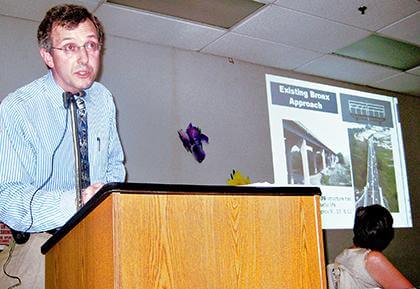By Connor Adams Sheets
The MTA is making progress on the rehabilitation of the Bronx-Whitestone Bridge and work on the Queens approach is slated to begin in 2011 — a year earlier than originally planned.
Vince Montanti, the Metropolitan Transportation Authority facility engineer leading the project, updated Community Board 7 Monday evening on the ongoing efforts to upgrade the 71-year-old span and said work on the Throgs Neck Bridge will conclude within weeks, relieving traffic there.
Work on the suspended span of the Bronx-Whitestone Bridge began in 2003 and concluded in 2009. In 2008, work on the Bronx approach, which is expected to end in 2012, began.
The next step is work on the Queens approach, which will begin in late 2010 or early 2011 and conclude by the end of 2014. That portion of the work was originally slated to begin in 2012, but heavy truck traffic diverted from the Throgs Neck Bridge as a result of the work there increased stress on the approach, which was recently rated deficient, making the work more urgently needed.
The Queens approach work will be a major headache for nearby residents and drivers in northeast Queens, as it will include closures of the 3rd Avenue exit off the Whitestone Expressway for between one and 1 1/2 years and other road closures as needed, Montanti said.
“This project will be difficult to implement and it will be difficult as far as traffic. We’re looking to mitigate as much as we can to make it as smooth as possible,” he said. “We have to shut down one lane at a time to replace the deck.”
Costing $200 million, the project to replace the entire 1,010-foot Queens approach viaduct and widen it to offer three 12-foot-wide lanes, will occur in three phases, according to Montanti. It will start at the end of 2010 or early 2011 with the relocation of the playground in Francis Lewis Park to a section of the park further from the bridge.
The replacement of the roadway will begin in early 2012 and end in late 2013. Next will be the demolition of the existing piers, which will conclude by the end of 2014. Sometime after 2020, the MTA will likely need to replace the entire bridge’s main cables.
Montanti said a contributing factor to deciding to do the entire rehabilitation project was the fact that the agency has spent $200 million just maintaining the bridge since 2000.
CB 7 board member Warren Schreiber and CB 7 Chairman Eugene Kelty requested that the MTA post warning signs and take other measures to reduce the significant impact the work will have on traffic.
“Somehow you have to move the traffic,” Schreiber, who also serves as president of the Bay Terrace Community Alliance, told Montanti. “For Bay Terrace, Whitestone and Bayside that bridge is the main way in and out for these communities.”
Community members also raised concerns about how the MTA will ensure that the Queens approach project, which is at 95 percent design completion and has yet to go out for bidding, will be clean and have minimal environmental impacts on the surrounding residential communities.
“We’re smack in the middle of a residential neighborhood, so we’re not going to be able to work at night, we’re not going to be able to work extended hours during the day and we won’t be able to work much on the weekends,” Montanti said. “The contractor will be required, daily, to clean, sweep, wet down just to maintain the perimeter of the site to make sure the site stays clean.”
Reach reporter Connor Adams Sheets by e-mail at csheets@cnglocal.com or by phone at 718-260-4538.

































